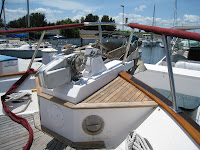There’s a trick to removing bungs and the underlying screws! Most bungs are 3/8″ or the next increment smaller. You’ll want to get a large “nail” slightly smaller than the bung (for a 3/8″ bung, get a 5/16″ “nail” or bolt). Cut the pointy end off the nail so you have a nice flat surface. Place the nail in the center of the bung and give it a tap with a hammer; that creates an indentation in the bung with the surrounding wood still standing proud and frees up the edge of the bung. Then using a small drill bit (no bigger than 1/8″) drill a hold in the center of the bung down until it bottoms out on the underlying screw (the bit will stop when it hits the screw). Position a construction screw in the hole and using an electric drill screw the construction screw down the hole you drilled; it will bottom out on the underlying screw and lift the bung right out of the hole! Any remaining bung material in the hole you can get out with an awl or small screw driver.
Then you you’ll have access to the underlying screw. It will probably be a Phillips head screw on an older boat; if you catch a bad break it will be a standard single channel (they’re much harder to remove). With a Phillips head you can take a Phillips head bit and set it on the screw into the X channels and give it a good hard tap with a hammer which will loosen the screw in the hold and break it away from any “glue” that might have been used to put it in place and also gouges out any leftover material in the X channels; once you’ve done that it should back out relatively easily. This should work (based on my experience) about 90% of the time; the remaining 10% of the time you may have to drill out the screw or use a screw extractor to “grab” the screw and back it out.

